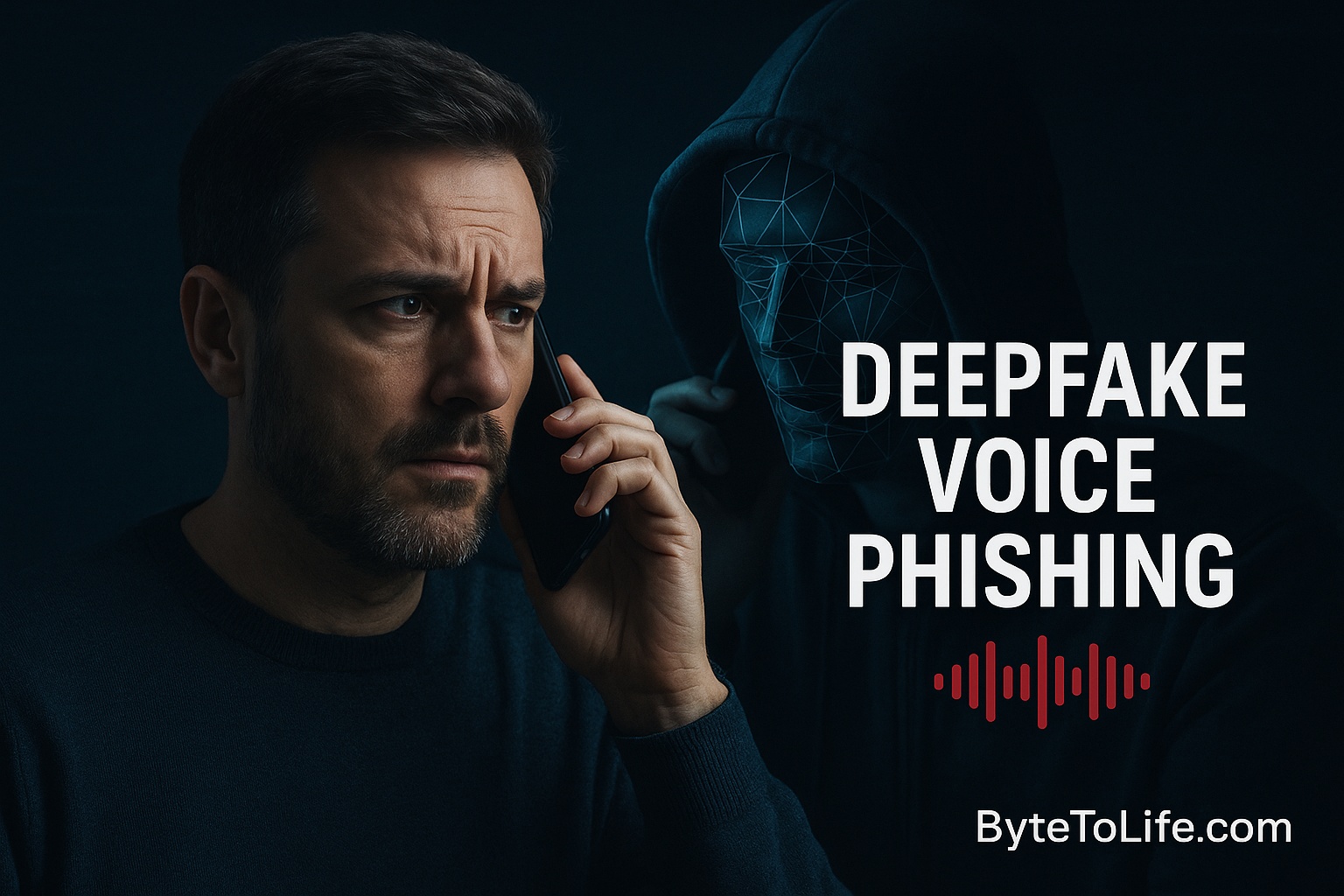Picture receiving a sudden call from your company’s CEO, urging you to transfer money immediately. The voice is unmistakably theirs—but it’s a deepfake. In 2025, this scenario is no longer hypothetical. With the explosive growth of AI-powered voice cloning tools, cybercriminals are weaponizing “vishing” (voice phishing) to deceive individuals and companies alike.
What Is Vishing and How Has It Evolved?
Vishing, or voice phishing, is a form of social engineering where attackers impersonate trusted entities over phone calls to extract sensitive information or coerce victims into taking harmful actions.
Key Characteristics of Modern Vishing:
- AI voice cloning replicates real voices within minutes.
- Real-time deepfake synthesis enables live conversations with impersonated voices.
- Spear-vishing tactics target specific individuals using contextual data from LinkedIn or data breaches.
Why Deepfake Voice Tech Is a Game Changer
Traditional vishing relied on social manipulation and basic scripts. Now, with AI, attackers can replicate vocal tone, cadence, and emotion. Tools like Descript’s Overdub or Resemble AI allow anyone to create realistic voice models from short audio samples.
Deepfake Voice Technology: How It Works
- Input: 30 seconds to 2 minutes of target’s voice (from YouTube, TikTok, etc.).
- Training: Neural networks analyze patterns in speech.
- Output: A digital clone that can say anything in the target’s voice.
Recent Case Studies and Data
According to the CrowdStrike Global Threat Report 2025, vishing attacks increased by 442% in late 2024, and a significant portion now involve AI-generated voices.
Real Incident Examples:
- A multinational firm lost $240,000 after a finance employee followed fake voice instructions from a “CEO.”
- Cybersecurity researchers recreated the voices of famous tech leaders to test social engineering vulnerability—and succeeded.
The Psychological Factor: Why It Works
Humans trust voices. Unlike suspicious emails, a familiar voice often bypasses critical thinking. Attackers exploit urgency, authority, and fear. This is especially effective when preceded by phishing emails or SMS (a multi-vector attack).
Who Is at Risk?
- Executives and employees in finance or HR
- Healthcare and government sectors with sensitive data
- Small businesses with little to no cybersecurity training
- Remote teams with less face-to-face verification
Detection and Prevention: What Can You Do?

1. Awareness and Training
Train staff to verify unusual requests—even if they sound authentic. Use callback procedures or internal confirmations.
2. Technical Tools and Solutions
- Voice deepfake detection tools like Pindrop and Deepware
- Biometric authentication that relies on behavior rather than voice
- Internal communication apps with secure audio verification
3. Operational Safeguards
- Set internal rules: no transactions over phone alone
- Use multi-factor authentication (MFA)
- Keep a documented reference of common cyberattack methods accessible to staff
How Enterprises Can Strengthen Defense
For companies, it’s essential to integrate AI-specific risk into your cybersecurity strategy. A few steps include:
- Invest in red-team simulations using AI-generated voices
- Conduct regular incident response drills
- Review voice biometric systems for vulnerabilities
Ethical and Legal Implications
Deepfake vishing raises serious ethical concerns. Is impersonating someone’s voice considered identity theft? While laws are catching up, many jurisdictions now classify it as criminal fraud. Still, regulations on AI-generated voice misuse remain limited.
Future Outlook: The Arms Race Between Attackers and Defenders
As synthetic voice tools become more widely available, we’ll likely see a rise in both the scale and the sophistication of attacks. The cybersecurity industry is already responding with AI-driven detection methods, but it’s a cat-and-mouse game.
What to Expect:
- AI-for-good tools to detect synthetic voices in real-time
- Public voiceprints as a digital signature
- Better authentication frameworks beyond voice and email
How Attackers Collect Voice Samples
One of the scariest parts of voice deepfake technology is how easily attackers can gather audio samples of their targets. Public sources like YouTube interviews, TikTok videos, podcast appearances, webinars, and even voicemail greetings can provide ample data. These sources are often overlooked in personal security strategies, making them ideal for malicious actors.
Steps Attackers Typically Follow:
- Step 1: Find a target on LinkedIn or social media.
- Step 2: Search for audio content involving the target.
- Step 3: Extract and clean voice samples.
- Step 4: Use AI tools to synthesize a clone.
- Step 5: Launch vishing attack via spoofed call or VoIP.
Why Traditional Cybersecurity Measures Fall Short
Most businesses rely on standard cybersecurity measures such as firewalls, email filters, and antivirus software. Unfortunately, these tools do little to protect against vishing or voice-based social engineering attacks. That’s because deepfake vishing attacks do not require malware or code — they manipulate human psychology directly.
The Role of Social Media in Amplifying Risk
Social media platforms have become goldmines for cybercriminals. When professionals post video content or audio clips online, they unknowingly provide material for voice cloning. Additionally, attackers can map out relationships and organizational charts to make their impersonations more convincing.
Deepfake Voice in Fraud Beyond Vishing

Voice deepfakes aren’t just being used for phishing. Criminals are deploying them in:
- Insurance fraud: Faking injury reports via call-ins.
- Customer service scams: Impersonating clients to access accounts.
- Political manipulation: Creating fake speeches or calls from public officials.
Combating the Threat: AI vs. AI
Cybersecurity experts are turning to AI tools to defend against AI-driven threats. Several startups and research labs are developing real-time voice authentication and deepfake detection algorithms. These tools analyze audio patterns, cadence irregularities, and subtle artifacts that synthetic voices often fail to mask.
Promising Tools in Development:
- Pindrop: Detects synthetic speech and verifies call metadata.
- Respeecher Deepfake Detection: Offers APIs for verifying synthetic content.
- Deepware Scanner: Scans uploaded audio for deepfake probability.
How to Protect Your Voice Identity
As voice becomes a new biometric frontier, individuals need to treat it like a password. Protecting your vocal identity is just as important as protecting your data.
Best Practices for Individuals:
- Avoid posting long-form voice recordings publicly.
- Use aliases or avatars in sensitive audio content.
- Enable voiceprint monitoring if available through your bank or telecom provider.
Policy and Regulation: Where Do We Stand?
While some countries are beginning to recognize the danger of AI-generated impersonation, global policy frameworks remain limited. In the United States, states like California and Texas have enacted laws against malicious use of deepfakes. However, enforcement is difficult, especially when attacks are cross-border.
VoIP and Spoofed Calls: A Technical Enabler
Voice over IP (VoIP) services allow attackers to make calls from virtually any number, including numbers that appear to be internal company lines or government agencies. By combining spoofed caller IDs with AI voice cloning, attackers create a nearly untraceable and highly persuasive scam.
Why Spoofed Numbers Work:
- Employees trust internal numbers and familiar area codes.
- Caller ID systems are not built to verify authenticity.
- Many VoIP platforms lack security features by default.
Voice Cloning-as-a-Service (VCaaS): The Dark Market
Just as ransomware-as-a-service (RaaS) became popular on the dark web, voice cloning tools are now being offered as easy-to-use services. Some forums advertise real-time voice synthesis APIs for just a few dollars. These services often come with tutorials and support, making cybercrime more accessible than ever.
Comparing Human and Synthetic Voices
Even seasoned security professionals struggle to detect high-quality deepfake voices. Research shows that with just two minutes of voice sample input, a synthetic model can fool listeners with up to 85% accuracy in short conversations.
Subtle Tells of a Deepfake Voice:
- Slight delays in responses (latency)
- Inconsistent emotion or emphasis
- Unnatural intonation during long sentences
Recommended Organizational Policies
To address this evolving threat, organizations should implement specific voice-related protocols:
- Develop a list of “high-risk” communication channels (e.g., financial approval via phone).
- Mandate two-party authentication for sensitive requests.
- Use keyword verification—predetermined code words in verbal approvals.
- Deploy AI call monitoring for anomaly detection.
Integrating Deepfake Awareness into Cybersecurity Training
Security awareness programs should now include deepfake education modules. These can involve:
- Audio simulation exercises: Let staff hear deepfake vs. real audio.
- Incident response drills with deepfake voice scenarios.
- Live demonstrations using publicly available tools (in a controlled environment).
Voice Biometrics: A Double-Edged Sword?
While voice biometrics are gaining popularity for authentication, they are also vulnerable to deepfakes. In fact, several reports in 2024 highlighted successful bypasses of biometric systems using cloned voices. As a result, vendors are now combining voice biometrics with behavioral analytics to mitigate this risk.
Public Education and Media Responsibility
Media outlets and influencers can play a crucial role in raising awareness. Public service announcements, news segments, and short-form social media videos help demystify deepfakes and educate the broader population.
Frequently Asked Questions (FAQ)
What is AI voice phishing?
AI voice phishing, also known as deepfake vishing, is a cyberattack where criminals use artificial intelligence to clone someone’s voice and impersonate them in phone calls. These calls are used to manipulate victims into transferring money, revealing sensitive data, or taking unauthorized actions.
How can I tell if a voice is fake?
While deepfake voices can sound incredibly real, subtle signs like unusual pauses, monotone delivery, or slightly off timing can be indicators. Some detection tools can also help identify synthetic voices in real-time, but these are still developing technologies.
Can deepfake voice attacks bypass voice biometrics?
Yes, in some cases. Advanced voice clones have been shown to fool certain biometric authentication systems. This is why many organizations are moving toward multi-factor authentication and behavioral biometrics in combination with voice recognition.
How do attackers get my voice?
Cybercriminals frequently gather voice recordings from openly available content such as YouTube, podcasts, webinars, and voicemail messages. It only takes about 30 seconds to 2 minutes of clean audio to generate a realistic voice clone using AI.
What should I do if I receive a suspicious voice call?
Never act on sensitive requests from a voice call alone, even if the voice sounds familiar. Always confirm using a different communication method such as email or an internal messaging system. If someone says they’re from a bank or government agency, end the call and contact the official line yourself.
Can individuals protect themselves from voice cloning?
Yes. Avoid posting long audio recordings online, limit public exposure of your voice, and use pseudonyms or avatars when possible. Also, stay informed about deepfake technologies and educate others around you.
Conclusion
AI-powered voice phishing represents one of the most unsettling evolutions in cybercrime. With the rapid evolution of deepfake technology, our security measures must evolve as well. Whether you’re a tech-savvy professional or a casual smartphone user, understanding the threat is the first step in staying protected. Never trust a voice alone—verify every time.
For more updates on AI threats and digital security, check out the AI section of ByteToLife.com.



